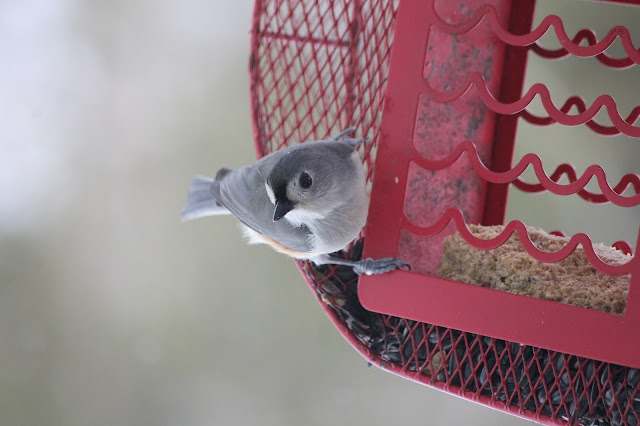Like most
places, a great deal of natural habitat has disappeared in the Poconos, due to
the rapid growth of residential areas and how we maintain
our homes. The World Wildlife Fund stated in 2020 that human activities caused
wildlife to decline by more than two-thirds in the previous fifty years. As a child in England, I loved to gather bluebells from the
woods and catch tadpoles to watch as they changed into frogs. I want my
great grandchildren to have similar experiences. Loss of habitat is the
number one threat to wildlife today. The National Wildlife Federation
has identified how we can provide for the needs and conditions that
enable wildlife to survive and thrive.
 |
| I am proud to say my garden is a certified Wildlife Habitat. |
I follow the National Wildlife Federation guidelines for a quality habitat by providing food, water, cover, and places for creatures to raise their young.
1. FOOD
The best food source is seeds, berries, nectar, nuts, and fruit from plants.
 | |
| Black swallowtail butterfly on garden phlox Phlox paniculata 'Bright Eyes' |
Native plants are most desirable. I have many in my gardens, and I am installing a wildflower meadow planted with native plants. No pictures of the meadow yet, as I just seeded it.
 |
| Bee on Turtlehead flower |
 |
| There are lots of butterflies in my garden |
Feeders supplement the food I provide through my plantings. My husband, Duane, tried various types of feeders over the years. None are really squirrel-proof.
 |
| Our latest bird feeder holds seeds and suet |
 |
| Tufted Titmouse |
Duane provides suet as a high energy food for the winter.
 |
| Red-bellied Woodpecker |
2. WATER
If birds can't bathe, their feathers become dirty making flying
difficult. Our koi pond is well utilized for this purpose. It is also home to aquatic wildlife such as frogs and toads. Dragonflies and other insects enjoy the aquatic plants.
 |
| Eight-spotted Skimmer Libellual forensis |
Also, we provide bird baths and fountains.
 |
| In the winter the bluebirds love the heated water dish. |
.jpeg) |
| A hummingbird stops for a drink at our water fountain. |
The Ruby-throated Hummingbird arrives in Pennsylvania in April. The hummingbird is the bird that pollinates. It hovers at flowers and feeds on nectar.
3. COVER
Wildlife needs shelter from the weather and predators. We are fortunate to have wooded areas, thickets, and bramble
patches at the
farm. We leave dead trees standing where possible. When the branches
fall, the holes provide nesting places and cover. Woody debris is
an essential source of shelter for insects, invertebrates, and small
mammals.
 |
| Standing dead trees are called snags. |
You can create a log and brush pile to form a 'wildlife hotel.' This turtle lived under our brush pile.
 |
| A wildlife hotel for mason bees and other insects located at the back of the potting shed. |
4. PLACES TO RAISE THEIR YOUNG
Duane places birdhouses throughout the gardens.
 |
| Birdhouses provide cover for wildlife in winter. |
 |
| My favorite birdhouse with a rooftop garden. |
Many places that provide cover for wildlife are also the best places for raising their young.
 |
| This robin made her nest in the grapevine on our pergola. |
I plant butterfly host plants to give caterpillars food to eat and a place to grow through their lifecyle. Milkweed is the host plant for the Monarch butterfly.
 |
| Swamp milkweed Asclepias incarnata |
 |
| Caterpillar of the monarch butterfly on a milkweed leaf. |
Finally, if we want birds, bees, and butterflies in our gardens, it is
necessary to practice SUSTAINABLE GARDENING. I addressed this in a previous post called, Practicing Sustainability in the Garden. Click on the link to read it.
The rewards of gardening for wildlife are many. For me it adds beauty to my garden, improves air, water, and soil quality, restores habitats, and best of all it is FUN!
This is my first entry in the May #GardenBloggersChallenge. The challenge is for members of GardenComm, the association for garden communicators, and anyone else who would like to participate. There are daily blog topics and you can participate as much or as little as you like. Add #GardenBloggersChallenge to the content of your post. Why don't you join in the fun?







I always enjoy your posts, but this one was even more enjoyable! I wonder if the mason bees use their “hotel”? I have planted virtually every plant you featured. And you reminded me I have a bottle bird house…haven’t seen it recently. Thank you!
ReplyDeleteIn my garden, every month is "garden for wildlife." One of my daughters just got me a new bee/insect home for Mother's Day. She knows my heart!
ReplyDeleteI always enjoy seeing the wildlife which visits your garden. I know how fast those little hummingbirds are so you did well to get such a great photo, and the turtle is fabulous. I think we're aware, now more than ever, that our wildlife is in decline and it's up to us to turn things around. Some great information here.
ReplyDelete